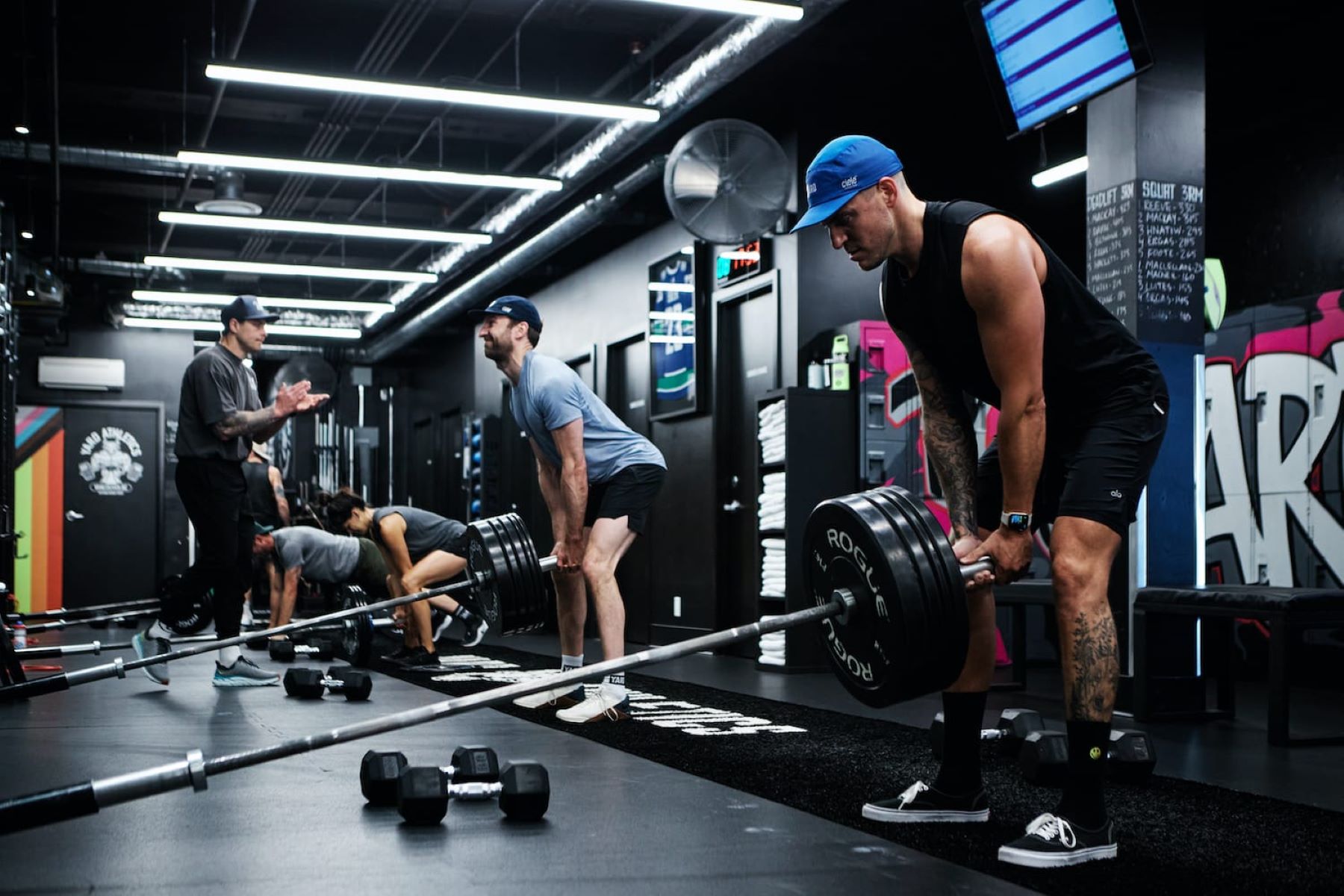Home>Misc>Featured>How Can We Use Muscle Strength And Conditioning Exercises To Increase Athletic Performance


Featured
How Can We Use Muscle Strength And Conditioning Exercises To Increase Athletic Performance
Modified: January 22, 2024
Enhance athletic performance with featured muscle strength and conditioning exercises. Boost your fitness level and maximize your potential on the field.
Introduction
Athletic performance is influenced by a multitude of factors, and one key component is muscle strength and conditioning. Whether you’re an elite athlete striving for peak performance or a recreational sports enthusiast looking to improve your game, incorporating muscle strength and conditioning exercises into your training regimen can provide significant benefits.
Muscle strength refers to the ability of a muscle or group of muscles to generate force, while conditioning involves the overall fitness and endurance of the body. Both aspects are crucial for athletic success, as they directly impact an athlete’s power, speed, agility, and overall performance.
In this article, we will explore the importance of muscle strength and conditioning for athletic performance and discuss various types of exercises that can be utilized. We will also delve into the benefits of incorporating these exercises into your training routine, provide guidelines for implementation, and share an example training program for increasing athletic performance.
Whether you’re a runner, basketball player, or weightlifter, understanding how to optimize muscle strength and conditioning can take your performance to new heights. By incorporating targeted exercises and following proper training protocols, you can enhance your physical capabilities, minimize the risk of injury, and achieve your athletic goals.
So, let’s dive in and explore the world of muscle strength and conditioning exercises and how they can propel you towards peak performance.
Understanding Muscle Strength and Conditioning
Muscle strength and conditioning are fundamental components of athletic performance. To fully grasp their importance, it’s essential to understand what these terms mean and how they contribute to athletic success.
Muscle strength refers to the capacity of a muscle or group of muscles to generate force. It is dependent on various factors, including muscle size, fiber type composition, neurological adaptation, and biomechanics. Having adequate muscle strength is crucial for athletes as it enables them to produce power, overcome resistance, and execute explosive movements.
On the other hand, conditioning is a broader concept that encompasses overall fitness, endurance, and cardiovascular health. It involves improving the body’s ability to sustain prolonged physical activity and recover efficiently. Conditioning allows athletes to maintain performance levels throughout a game, match, or event, reducing fatigue and enhancing overall endurance.
Successful athletic performance requires a harmonious combination of both muscle strength and conditioning. Having great strength without adequate conditioning can result in early fatigue and a decline in performance. Conversely, being well-conditioned but lacking muscle strength can limit an athlete’s power output and explosive capabilities.
By focusing on both aspects, athletes can optimize their physical abilities and excel in their respective sports. Developing muscle strength allows athletes to generate more power, accelerate faster, and overcome opponents or obstacles. Conditioning, on the other hand, ensures that athletes can sustain high-intensity efforts, maintain optimal performance for extended periods, and recover quickly between exercises or bouts of activity.
It’s crucial to note that muscle strength and conditioning are not mutually exclusive. In fact, they often complement each other in training programs. Strength exercises can improve overall conditioning by incorporating elements of endurance and cardiovascular fitness. Likewise, conditioning exercises can enhance muscle strength by maintaining muscle hypertrophy, improving muscular endurance, and increasing power output.
Understanding the intricate relationship between muscle strength and conditioning is imperative for athletes and trainers alike. By incorporating both into training programs, athletes can maximize their potential, optimize performance, and achieve their goals in their respective sports.
Importance of Muscle Strength and Conditioning for Athletic Performance
Muscle strength and conditioning play a pivotal role in enhancing athletic performance across various sports and disciplines. Let’s explore the reasons why these two components are crucial for athletes looking to reach their full potential.
1. Enhanced Power and Explosiveness: Building muscle strength allows athletes to generate more power and produce explosive movements. Strong muscles contribute to increased force production, enabling athletes to run faster, jump higher, and deliver more forceful strikes or throws. Whether you’re a sprinter, basketball player, or martial artist, having strong muscles is essential for maximizing power output.
2. Improved Speed and Agility: Muscle strength and conditioning exercises can significantly improve an athlete’s speed and agility. Strong muscles provide a solid foundation for quick acceleration and rapid changes in direction. Additionally, conditioning exercises enhance endurance, allowing athletes to maintain high-intensity efforts over extended periods, which can be particularly beneficial in endurance sports or sports where repeated sprints are required.
3. Reduced Risk of Injury: Adequate muscle strength and conditioning help to prevent injuries in sports by improving joint stability and enhancing the body’s ability to withstand physical stresses. Strong muscles protect joints and connective tissues and can help absorb impact forces. Conditioning exercises also improve flexibility and mobility, reducing the risk of strains, sprains, and other common sports-related injuries.
4. Increased Resilience and Recovery: Conditioning exercises improve cardiovascular fitness and overall endurance. This increased conditioning enables athletes to recover faster between bouts of intense activity and helps minimize fatigue during prolonged competitions. With improved resilience and quick recovery, athletes can maintain optimal performance levels throughout a game or event, avoiding a decline in skills due to fatigue.
5. Sport-Specific Performance Benefits: Different sports require different physical qualities. Muscle strength and conditioning exercises can be tailored to target specific muscle groups and energy systems relevant to a particular sport. This specificity helps athletes develop sport-specific skills and improve performance in their chosen discipline. Whether it’s hitting harder in tennis, lasting longer in endurance events, or outmuscling opponents in combat sports, targeted training can make a significant difference.
6. Mental Strength and Confidence: The physical benefits of muscle strength and conditioning also have a positive impact on an athlete’s mental game. Experiencing improvements in performance, power, and endurance can boost an athlete’s confidence and self-belief. This newfound mental strength can translate into a more focused and determined mindset, leading to improved performance under pressure.
From enhancing power and agility to reducing the risk of injury and improving mental resilience, muscle strength and conditioning are vital for athletes looking to excel in their respective sports. Incorporating these elements into training programs can unlock an athlete’s full potential, leading to improved performance and better overall athletic outcomes.
Types of Muscle Strength and Conditioning Exercises
There are various types of muscle strength and conditioning exercises that athletes can incorporate into their training programs. These exercises target different muscle groups and energy systems, helping to improve overall athletic performance. Let’s explore some key types:
- Resistance Training: Resistance training involves using external resistance, such as free weights, machines, resistance bands, or bodyweight exercises, to build muscle strength and power. Exercises like squats, deadlifts, bench press, and pull-ups are examples of resistance exercises that target major muscle groups and enhance overall strength.
- Plyometric Training: Plyometric exercises focus on explosive, rapid movements that involve quick muscle contractions to develop power and improve athletic performance. These exercises often involve jumps, hops, and bounds, such as box jumps, depth jumps, and power skips. Plyometric training is particularly beneficial for sports like basketball, soccer, and track and field events.
- Cardiovascular Training: Cardiovascular exercises, such as running, swimming, cycling, or rowing, are vital for improving overall conditioning and endurance. These activities stress the cardiovascular system, improve lung capacity, and increase the body’s ability to utilize oxygen efficiently. Cardiovascular training helps athletes maintain performance levels during prolonged activities and recover faster between bouts of intense effort.
- Interval Training: Interval training involves alternating between short bursts of high-intensity exercise and periods of active recovery. It effectively combines cardiovascular conditioning and power development. For example, a sprinter may perform repeated sprints at maximum effort, followed by a period of light jogging or walking. Interval training is an excellent tool for improving speed, endurance, and anaerobic fitness.
- Flexibility and Mobility Exercises: Flexibility and mobility exercises are crucial for injury prevention and optimal performance. These exercises enhance joint range of motion, improve muscle length, and promote better movement patterns. Examples include dynamic stretches, yoga, and specific mobility drills tailored to an athlete’s needs.
- Functional Training: Functional training focuses on movements that mimic activities performed in daily life or specific sports. These exercises improve overall strength, stability, balance, and coordination. Examples of functional training exercises include medicine ball throws, stability ball exercises, and exercises using suspension trainers like TRX.
Note that the selection of exercises should be tailored to an athlete’s specific sport, goals, and individual needs. It is advisable to work with a qualified strength and conditioning coach or a sports performance specialist to design a comprehensive training program that incorporates a variety of exercises to target different muscle groups and energy systems.
By incorporating a well-rounded combination of these muscle strength and conditioning exercises, athletes can optimize their physical capabilities, improve performance, reduce the risk of injury, and ultimately, excel in their respective sports.
Benefits of Muscle Strength and Conditioning Exercises
Muscle strength and conditioning exercises offer a wide range of benefits for athletes across different sports and levels of competition. Let’s take a closer look at some of the key advantages of incorporating these exercises into training programs:
- Improved Performance: One of the primary benefits of muscle strength and conditioning exercises is enhanced athletic performance. Building strength and power improves an athlete’s ability to generate force, resulting in faster sprints, higher jumps, and more explosive movements. Conditioning exercises improve endurance, allowing athletes to maintain a high level of performance for longer durations.
- Injury Prevention: Muscle strength and conditioning exercises help to minimize the risk of injuries. Strengthening the muscles, bones, and connective tissues increases joint stability and resilience. Additionally, conditioning exercises improve flexibility, mobility, and body control, which can reduce the likelihood of strain, sprains, and other common sports injuries.
- Increased Muscle Mass and Bone Density: Resistance training, a key component of muscle strength exercises, stimulates muscle hypertrophy, leading to increased muscle mass and strength. This is beneficial for athletes as greater muscle mass contributes to improved power and force production. Additionally, resistance training also stimulates bone remodeling and helps increase bone density, reducing the risk of fractures.
- Enhanced Metabolic Health: Muscle strength and conditioning exercises have a positive impact on metabolic health. Resistance training helps to increase muscle mass, which raises the body’s metabolic rate and promotes fat loss. Additionally, cardiovascular conditioning exercises contribute to improved heart health, blood circulation, and overall cardiovascular fitness.
- Improved Body Composition: Regular muscle strength and conditioning exercises contribute to favorable changes in body composition. Resistance training promotes muscle growth while reducing body fat. This enhances an athlete’s physique and can lead to better performance in sports that require a high strength-to-weight ratio.
- Boosted Mental Resilience: Engaging in muscle strength and conditioning exercises has a positive impact on an athlete’s mental well-being. Regular exercise stimulates the release of endorphins, which can improve mood, reduce stress, and enhance overall mental resilience. This can translate into improved focus, concentration, and confidence on and off the field of play.
It is important to note that the benefits of muscle strength and conditioning exercises are not limited to elite athletes. Individuals of all fitness levels can experience significant improvements in performance, health, and overall quality of life by incorporating these exercises into their workout routines.
Remember to prioritize proper technique, ensure gradual progression, and individualize exercises according to specific needs and goals. If you’re new to strength and conditioning exercises, it’s always recommended to consult with a certified strength and conditioning specialist or a qualified fitness professional to ensure safe and effective implementation.
By consistently engaging in muscle strength and conditioning exercises, athletes can unlock their true potential, maximize performance, and enjoy the numerous physical and mental benefits that come with a well-rounded training program.
Guidelines for Implementing Muscle Strength and Conditioning Exercises
Implementing muscle strength and conditioning exercises requires strategic planning and adherence to certain guidelines to ensure safety, effectiveness, and optimal performance gains. Let’s explore some important considerations when incorporating these exercises into your training program:
- Set Clear Goals: Define your specific goals and objectives for the strength and conditioning component of your training. Whether it’s increasing power, improving endurance, or enhancing overall performance, having clear goals will help in designing an effective program.
- Gradual Progression: Avoid rushing into high-intensity or advanced exercises. Gradually progress your training volume, intensity, or resistance to allow your body to adapt and minimize the risk of injury. Focus on mastering proper technique before increasing the load or difficulty level.
- Variety and Specificity: Include a variety of exercises that target different muscle groups and energy systems. This helps prevent training plateaus, enhances overall fitness, and improves performance. Additionally, tailor your exercises to be specific to the demands of your sport or activity.
- Proper Technique: Emphasize correct form and technique during all exercises. This ensures effective muscle recruitment, reduces the risk of injury, and maximizes results. If needed, seek guidance from a qualified strength and conditioning professional to learn proper technique for each exercise.
- Consistency and Frequency: Consistency is key when it comes to strength and conditioning exercises. Aim for regular training sessions and stick to your training schedule. The frequency of your workouts will depend on your individual needs, goals, and recovery capacity. Start with 2-3 sessions per week and gradually increase as your fitness improves.
- Recovery and Rest: Allow yourself adequate rest and recovery between training sessions to avoid overtraining and promote optimal muscle repair and growth. Incorporate rest days into your training schedule, listen to your body, and prioritize quality sleep and nutrition.
- Warm-up and Cool-down: Always begin your workout with a proper warm-up to prepare your body for the upcoming exercises. Include dynamic stretches, mobility drills, and light cardio activities to increase blood flow, improve joint mobility, and activate the muscles. Similarly, finish your workout with a cool-down, consisting of static stretches and light movement, to promote muscle recovery and prevent stiffness.
- Monitor Progress: Keep track of your performance, including weights lifted, repetitions completed, and times achieved in conditioning exercises. Regularly assess your progress to identify areas of improvement and adjust your training program accordingly.
- Listen to Your Body: Pay attention to your body’s signals and adjust your training accordingly. If you experience pain, excessive fatigue, or any concerning symptoms, modify or scale back your workouts and seek professional advice if necessary. Your long-term health and well-being should always take precedence.
Remember, successful implementation of muscle strength and conditioning exercises requires a balance between pushing yourself to the right intensity and allowing for adequate recovery. It is also strongly recommended to consult with a certified strength and conditioning specialist or fitness professional to design a tailored program that considers your specific needs and goals.
By following these guidelines, you can ensure a safe, effective, and progressive approach to your muscle strength and conditioning training, leading to improved athletic performance and overall fitness.
Example Training Program for Increasing Athletic Performance
Designing a well-structured training program is essential for athletes looking to increase their athletic performance. While the specific exercises and intensity may vary depending on individual goals and sport-specific needs, here is an example of a training program that incorporates muscle strength and conditioning exercises:
- Warm-up: Begin with 10 minutes of light cardiovascular exercise, such as jogging or cycling, to increase blood flow and raise body temperature. Follow this with dynamic stretches, focusing on major muscle groups and joints involved in your sport.
- Strength Training: Perform compound exercises that target multiple muscle groups. Examples include squats, deadlifts, bench press, rows, and overhead presses. Aim for 3-4 sets of 8-12 repetitions with appropriate rest intervals between sets (typically 1-2 minutes). Choose weights that challenge you while maintaining proper form.
- Plyometric Exercises: Incorporate explosive movements like box jumps, medicine ball throws, and depth jumps to develop power and improve athleticism. Perform 3-4 sets of 6-10 repetitions with adequate rest intervals (around 2 minutes) between sets.
- Cardiovascular Conditioning: Engage in aerobic activities such as running, cycling, or swimming to improve endurance and cardiovascular fitness. Choose a duration and intensity that challenges you, whether it’s steady-state cardio or interval training. Start with 20-30 minutes and gradually increase the duration or intensity over time.
- Interval Training: Incorporate high-intensity interval training (HIIT) to improve anaerobic fitness and work capacity. Alternate between short bursts of maximum effort exercises (such as sprints, burpees, or kettlebell swings) and active recovery periods. Start with a 1:1 work-to-rest ratio (e.g., 30 seconds on, 30 seconds off) and progress to more challenging ratios as your fitness improves.
- Flexibility and Mobility: Dedicate time to static and dynamic stretching exercises to improve flexibility and mobility. Prioritize areas that are tight or prone to injury in your sport. Spend 10-15 minutes performing stretches, holding each stretch for 15-30 seconds.
- Cooldown: Finish your workout with 5-10 minutes of low-intensity cardiovascular exercise to gradually lower your heart rate. Follow this with static stretching exercises for major muscle groups, paying attention to any areas that feel tight or fatigued.
It’s important to note that this is just a general example and should be adjusted based on individual needs, goals, and the demands of your specific sport. Additionally, proper rest, nutrition, and recovery are essential components of any training program. Make sure to listen to your body, monitor progress, and make adjustments as necessary.
To maximize the effectiveness of this training program, it is recommended to work with a qualified strength and conditioning coach who can provide expert guidance, monitor your progress, and tailor the program to your specific needs and goals.
Remember, consistency, dedication, and proper execution are key to achieving optimal results and enhancing your athletic performance.
Considerations for Safety and Injury Prevention
When engaging in muscle strength and conditioning exercises, safety should always be a top priority. Here are some important considerations to keep in mind to minimize the risk of injury and ensure a safe training environment:
- Proper Form and Technique: Correct technique is paramount to reduce the risk of injury and maximize the effectiveness of exercises. Focus on maintaining proper posture, alignment, and range of motion throughout each exercise. If needed, seek guidance from a qualified professional to learn proper form and technique.
- Gradual Progression: Avoid the temptation to push your body beyond its limits too quickly. Gradually progress the intensity and volume of your workouts to allow for proper adaptation and reduce the likelihood of overuse injuries. Respect your body’s limitations and take the time to build a solid foundation before progressing to more advanced exercises.
- Appropriate Warm-up and Cool-down: Always start your training session with a thorough warm-up to prepare your muscles, joints, and cardiovascular system for exercise. This should include dynamic stretches, mobility drills, and a few minutes of light aerobic activity. Similarly, cool down with static stretching and light activities to promote recovery and reduce muscle soreness.
- Proper Equipment and Environment: Make sure you have access to the appropriate equipment and a safe training environment. Check the condition of your equipment, such as weights, resistance bands, or exercise mats, to ensure they are in good working order. Ensure your training area is well-lit, free of obstacles, and provides adequate space for safe movement.
- Rest and Recovery: Allow your body sufficient time for rest and recovery between training sessions. Overtraining can increase the risk of injury, decrease performance, and hinder progress. Listen to your body’s signals, prioritize quality sleep, and provide your muscles and joints with time to repair and rejuvenate.
- Listen to Your Body: Pay attention to any pain, discomfort, or unusual sensations during exercise. If something feels off or causes pain, stop the exercise or modify it as needed. Pushing through pain can lead to further injury. Consult with a healthcare professional if you experience persistent or severe pain.
- Balance Strength and Conditioning: It’s important to strike a balance between muscle strength and conditioning exercises. Neglecting one aspect can lead to imbalances and potentially increase the risk of injury. Incorporate a combination of resistance training, cardiovascular conditioning, and flexibility exercises to ensure a well-rounded training program.
- Seek Professional Guidance: If you’re new to strength and conditioning exercises or have specific concerns or goals, consider seeking guidance from a qualified strength and conditioning specialist or fitness professional. They can assess your individual needs, design a program tailored to your abilities and goals, and provide guidance on proper technique and injury prevention.
Remember, safety should always be prioritized over pushing your limits. While challenging yourself is important for progress, it’s equally essential to listen to your body, respect its limitations, and implement proper safety measures to reduce the risk of injuries during your muscle strength and conditioning training.
Conclusion
Muscle strength and conditioning exercises are vital for athletes looking to enhance their athletic performance. By incorporating these exercises into their training programs, athletes can reap numerous benefits, including improved power, speed, endurance, and overall physical capabilities.
Understanding the importance of muscle strength and conditioning is the first step towards optimizing athletic performance. Muscle strength provides the foundation for generating force and executing explosive movements, while conditioning helps athletes maintain performance levels, enhance endurance, and recover efficiently.
Implementing a variety of exercises is key to targeting different muscle groups and energy systems. Resistance training improves muscle strength and power, plyometric exercises enhance explosiveness, cardiovascular training boosts endurance, and flexibility exercises promote injury prevention and optimal body movement.
When incorporating these exercises into a training program, certain guidelines should be followed to ensure safety and effectiveness. Gradual progression, proper technique, warm-up and cool-down routines, and paying attention to individual needs and limitations are essential considerations.
Safety and injury prevention are paramount when engaging in muscle strength and conditioning exercises. Prioritizing proper form, listening to your body, providing adequate rest and recovery, and seeking professional guidance can help minimize the risk of injuries and promote long-term success.
In conclusion, by incorporating muscle strength and conditioning exercises into their training routines, athletes can optimize their physical abilities, improve performance, reduce the risk of injury, and ultimately achieve their athletic goals. With proper planning, dedication, and adherence to safety measures, athletes can unlock their full potentials and succeed in their respective sports.









